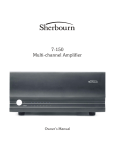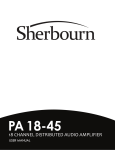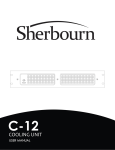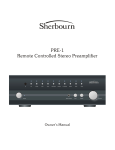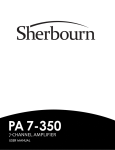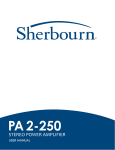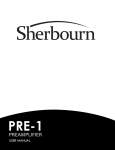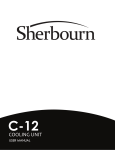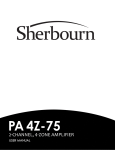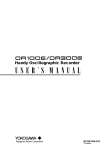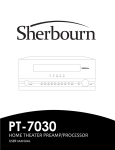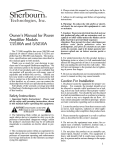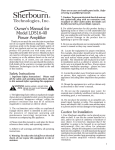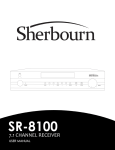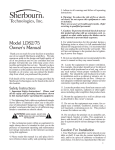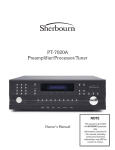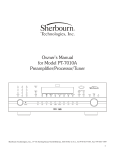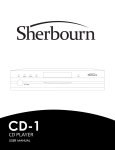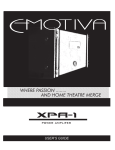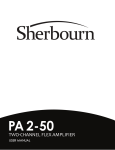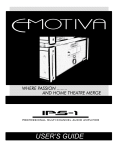Download Sherbourn Technologies CD-1 Troubleshooting guide
Transcript
Table of Contents 3 Thank You From Sherbourn 4 Safety Precautions 5 5 NEC (National Electrical Code) Standards A Note for the Cable Television (CATV) Installer 5 Antenna Grounding Outside the House 5 Unpacking Your Sherbourn Amplifier 6 7-150 Amplifier Features 7 Front Panel Layout 8 Rear Panel Layout 9 Installation and Connections 9 AC Power Considerations 9 Physical Placement / Heat Considerations 9 Input Connection Considerations 9 Output Connection Considerations 9 Connection Tips for Superior Sound 10 10 12V Trigger Connections Series and Parallel Speaker Connections 10 Series Connections 11 Parallel Connections 11 Technical Note about Multiple Speaker Connections 11 Troubleshooting Guide 11 No Sound (from one or more speakers connected to the amplifier) 12 The amplifier shuts down often or the line circuit breaker trips often 12 Poor Bass Performance From Full Range Speakers connected to the amplifier 12 Turn-on and turn-off thumps 12 “Hum” Noises in the Speakers 13 Other Probable Causes of Noise 13 One or more RED lights on the Front Panel are Blinking 13 Problems with the whole A/V System 14 7-150 Technical Specifications 14 Technical Features 14 Licensing and Trademark Disclosures 14 Service Assistance for Sherbourn Products 2 Thank You from Sherbourn Thank you very much for your decision to purchase one of our superb Sherbourn amplifiers. We take enormous pride in the design and build quality of all of our products and we are confident that our product will provide you with many years of enjoyable and trouble free service. Should you have any need to call upon our services please feel free to contact us at the address shown at the end of this booklet; or, of course, you can contact the dealership from which you purchased the product. Full details of the warranty coverage provided by Sherbourn Technologies can be found at the end of this booklet. Sherbourn 3 Safety Precautions The following situations require that your 7-150 be serviced only by qualified service personnel; 1. The power-supply cord or the plug has been damaged; or 2. Objects have fallen, or liquid has spilled into the component; or 3. The 7-150 has been exposed to rain; or 4. The 7-150 does not appear to operated normally or exhibits a marked change in performance; or 5. The 7-150 has been dropped, or its enclosure or chassis is damaged. Read this User’s Guide thoroughly before attempting to install and configure the 7-150 Amplifier. All the safety and operation instructions should be read before any operation of the component(s) begin. After successful installation and configuration of the 7150, be sure to retain this manual in a safe place for any future reference needs. All warnings on the 7-150 and in these operating instructions should be followed. Safety is a key component to a long lasting and trouble free installation. The vast majority of the subsequent safety precautions involve simple common sense. If you are not comfortable with the installation of audio/video entertainment equipment, it will be to your benefit to seek the services of a qualified installation professional or call us for help. The user should never attempt to service the 7-150 beyond the means described in this User’s Guide. All other servicing should be referred to Sherbourn or other qualified service personnel. To prevent electric shock, do not use this polarized plug with an extension cord, receptacle or other outlet unless the blades can be fully inserted to prevent blade exposure. The 7-150 should NEVER be used near water such as a bathtub, washbowl, kitchen sink, laundry tub, in a wet basement or near a swimming pool etc. There is a risk of electric shock to your body and permanent damage to the equipment. Electric shock may result in permanent bodily injury or death. Grounding or Polarization - Precautions should be taken so that the grounding or polarization means of the component is not defeated. This apparatus does not exceed the Class A /Class B (whichever is applicable) limits for radio noise emissions from digital apparatus as set out in the radio interference regulations of the Canadian Department of Communications. ATTENTION — Le present appareil numerique n’emet pas de bruits radioelectriques depassant las limites applicables aux appareils numeriques de classA/de class B (selon le cas) prescrites dans le reglement sur le brouillage radioelectrique edicts par les ministere des communications du Canada. The 7-150 should be situated so that its location or installation position does not interfere with proper ventilation. The 7-150 should not be situated on a bed, sofa, rug or similar surface that may block any ventilation openings; or placed in a built-in installation such as a bookcase, cabinet, or closed equipment rack that may impeded the flow of air through ventilation openings. If installed in a closed equipment rack for custom installations, be sure to add forced air ventilation so that it has adequate air circulation. For questions regarding service, contact: Sherbourn Technical Support 131 Southeast Parkway Court Franklin, Tn. 37064 615-791-4046 www.Sherbourn.com The 7-150 should be situated away from heat sources such as radiators, or any other devices which produce heat. The 7-150 should be connected to a power supply only of the type described in this User’s Guide and what is labeled on the 7-150 component. Power supply cords should be routed so that they are not in high foot traffic areas or pinched by item placed upon or against them, paying particular attention to cords at the wall plugs, convenience receptacles, and the point where they connect into the 7150. The power cord for the 7-150 should be unplugged from the outlet when unused for a long period of time or just turn off the main power switch on the back of the unit. WARNING - TO REDUCE RISK OF FIRE OR ELECTRIC SHOCK, DO NOT EXPOSE THIS APPLIANCE TO RAIN OR MOISTURE. CAUTION - TO PREVENT ELECTRIC SHOCK, MATCH WIDE BLADE OF PLUG TO WIDE SLOT, FULLY INSERT. CAUTION - DO NOT EXPOSE TO DRIPPING OR SPLASHING LIQUIDS, AND DO NOT PLACE OBJECTS FILLED WITH LIQUIDS, SUCH AS VASES, ON TOP OF THE 7-150. When it’s time for cleaning the 7-150, it should be cleaned only as recommended in this User’s Guide. Never spray liquids directly into the component’s vent openings. Care should be taken so that small objects do not fall into the inside of the 7-150. 4 NEC (National Electrical Code) Standards Unpacking the 7-150 All Sherbourn amplifiers are double boxed to survive the rigors of long distance shipping and arrive to you undamaged. The outer box may show wear and tear, but this is no cause for alarm. The outer box’s purpose is to protect the inner box. If the inner looks heavily damaged, and you are concerned about damage to the amplifier, please call Sherbourn Technical Support at 1-877-366-8324. A Note for the Cable Television (CATV) Installer This reminder is to call the CATV system installer’s attention to Article 820-40 of the NEC that provides guidelines for proper grounding and in particular, specifies that the cable ground shall be connected to the grounding system of the building as close to the point of cable entry as practical. Inside the laminated inner box, the amplifier is securely seated between to two reinforced pieces of high-density impact foam. At first glance, the cardboard backing on the foam may give the appearance of a third box, but it is easily lifted to reveal the amplifier, which is wrapped in static free plastic. The plastic sheeting is tucked underneath the amplifier and securely taped. It is recommended that the plastic sheeting be removed after the amp is lifted out from the box. Antenna Grounding Outside the House If an outside antenna is connected to the receiver, be sure the antenna system is grounded so as to provide some protection against voltage surges and built-up static charges. Article 810 of the National Electrical Code, ANSI/NFPA 70, provides information with regard to proper grounding of the lead-in wire to an antenna-discharge unit, connection to grounding electrodes, and requirements for the grounding electrode. See diagram below. The bottom piece of foam is molded to fit tightly against the amplifier, but there is a recessed area on each side, allowing you to get your hands under the amplifier and lift it out of the box. Note: These amplifiers are HEAVY! Lift with your legs! Inventory: Included with your 7-150 Amplifier should be an IEC Class 1 two prong power cord and this manual. It is important to save all the packing materials and the boxes in case your 7-150 ever needs to be moved or shipped back to the factory for service. Make sure you keep your sales receipt. It is the only way for Sherbourn to establish the duration of your Limited Warranty and it may come in useful for insurance purposes. Cable TV Coaxial Cable, Satellite Dish Cables and Television Antennas should be grounded BEFORE the point of entry into the house. Recording the Serial Number Please read the serial number located on the rear panel and record it below along with the date of purchase. Always observe proper antenna or satellite dish grounding techniques. When lightning strikes, there is always the possibility that your antenna or dish (mounted high on the roof) can become a conduit for lightning and electrically damage any equipment to which it’s connected. Additionally, proper grounding offers safety to the people using the audio/video system in the event of an electrical problem. Model Number 5 7-150 Serial Number ____________________ Place of Purchase ____________________ Date of Purchase ____________________ 7-150 Amplifier Features • Audiophile quality performance and sound • High current power supply • Low noise toroidal power transformer • Advanced microprocessor operating system • Complementary, discrete power amplifier design incorporating high current, high speed, on semiconductor power devices • Channel status indicators for standby, operate, and fault • 12 volt trigger connections • Completely stable into 4 ohm loads • Signal to Noise Ratio is greater than 100dB, unweighted ref. full output • THD .03% at rated power, 20Hz – 20kHz • Fully protected from all fault conditions • Soft start circuitry • External trigger turn on • Soft touch power switch • Heavy duty, rack standardized chassis w/ solid milled aluminum faceplate • IEC power inlet, 115/230 VAC Auto configurable 6 Front Panel Layout 1. Front Panel Power Switch This switch provides the ON/OFF control of the 7-150 from the front panel. When the unit is off and in standby mode, the switch illuminates amber. Automatic switching is accomplished with the 3.5mm trigger input on the rear panel using a 5-12VDC control signal. 2. Front Panel LED Display The front panel display contains Status LED lighting to indicate the condition of the 7-150. • NO LED = Amplifier is OFF • BLUE LED = Normal operational • FLASHING RED LED = Fault Condition - see “Troubleshooting” section for details. Note: The amplifier rear panel has an LED Status Selector which can turn the blue LEDs off. 3. Rubber Feet Do not remove the feet from your amplifier. In addition to minimizing vibration and insulating the amplifier from the surface it is placed on, these feet are essential in allowing airflow under the amplifier for proper cooling. 7 Rear Panel Layout 6. Remote Trigger Input – The 7-150 can be remotely triggered by another device, and in turn, remotely trigger another device. When a remote trigger output from a preamplifier, processor or other audio device is connected to the trigger input here, the amplifier will power up and shut down along with the first device. Another device (CD player, amplifier, etc) can be added to this chain using the tridder output. This 3.5mm jack accepts a 5-12 volt input for remote activation of the amplifier and mates directly with the Sherbourn processor trigger output. If building your own cable, center is positive and outer shield is negative. 1. Status LED Switch – Status LEDs can be turned on and off with this switch. 2. Unbalanced / Balanced Input Selector – When turned towards 'Un-Bal', the RCA (unbalanced) input is chosen and active. When turned towards 'Bal', the XLR / Balanced input is chosen and active. 3. XLR / Balanced Audio Input – Standard XLR input connection that connects to a standard XLR audio output connection on a preamplifier, receiver or multi-channel processor. 7. Speaker Outputs (5 way Binding Posts) - These are the speaker outputs. The 5 way binding posts accept stripped speaker wire, banana plugs (single or dual), or spade connectors. Be sure to observe correct polarity when connecting speakers and be sure that the wires do not touch between positive and negative terminals. 4. RCA / Unbalanced Audio Inputs – Standard RCA input connection that connects to a standard RCA audio output connection on a preamplifier, receiver or multi-channel processor. 8. Power Receptacle - This is a standard IEC 2 prong power receptacle. It is advised that this amplifier have a direct connection to a wall outlet. Do not plug into a “power strip”. Note: Potentially lethal voltages present! Never connect, disconnect or modify speaker wiring with the amplifier turned on. 5. Master Power Switch - This rocker switch provides the master power for the amplifier. After it is in the ON position, the amplifier can be turned on manually from the front panel switch or automatically with the trigger input via 3.5mm input jack. Under normal use, this switch should remain on, leaving the amplifier in standby position, and coming to full power with either the front panel 'standby' button, or activation through the remote trigger. 8 Installation and Connections Do NOT place a turntable directly above or directly adjacent to the amplifier. AC Power Considerations Before placing the amplifier on a shelf, verify that the weight bearing capacity of the shelf is 80 lbs or greater. The amplifier is heavy and should be placed toward the bottom of an audio rack to minimize the rack being unnecessarily top heavy. The majority of household electrical sockets (in places other than the kitchen and garage) are 15 amperes maximum, which is sufficient to power your Sherbourn amplifier. However, remember to account for the electrical power that other components will require if they share a common wall socket or electrical circuit. Most DVD players, preamplifiers and A/V source units are fairly low current items, and can successfully share a wall socket with your power amplifier, but big screen TVs and video projectors usually have minimum current requirements that can consume nearly an entire circuit. Refer to the owner’s manuals of your audio/video devices to assess your electrical power requirements for your home entertainment system. If you have any questions relating to issues with the power requirements for your Sherbourn amplifier, please contact Sherbourn Support at: 1-615-791-4046. Input Connection Considerations High quality, fully shielded RCA cables are recommended for use with Sherbourn amplifiers. ‘Twisted Pair’ cables are not recommended. Sherbourn amplifiers have an extremely high bandwidth, and twisted, non-shielded cables can actually act as an ‘antenna’, receiving outside interference and signals (EMI and RFI), which will cause the amplifier to go into protect mode. Whenever possible, keep preamplifier level audio cables away from amplifier electrical power cords by at least a few inches. Amplifier AC power cords are carrying much more current than other source and preamplifier components, which means there is a larger degree of noise or “hum” potential with the amplifier power cord in close proximity. Surge Protection - Along with built-in noise filtering, your Sherbourn amplifier is equipped with overcurrent, undercurrent, and spike protection. Upon powering up your Sherbourn amplifier with the front panel switch or via 3.5mm trigger input (switch on the rear panel must be set to “ON”), you will notice the front panel LED lighting starts off red for 5 seconds and then turns to blue. This indicates the amplifier is “ON,” functioning normally, and ready for operation. If you do not see an LED light or a blinking red LED light while the amplifier is on during (otherwise) normal operation, please refer to the troubleshooting section of this manual. Output Connection Considerations The output connectors provided on each channel of Sherbourn amplifiers are standard “binding post” speaker connectors with industry standard spacing. These are sometimes called 5-way binding posts because of the many ways in which the speaker wire can connect into the posts. The posts can accept bare wire, spade terminals, and dual or single banana connectors. Spade connections or banana plugs ensure a simple, solid fit in the terminal whereas bare wire may be awkward when the terminal is screwed down to compress the wire into place. Keep in mind that if you use “dual banana” plugs and “stack” them, you will be creating a parallel connection. For more details on series and parallel connections, see pages 13-14. Physical Placement /Heat Considerations Sherbourn series amplifiers employ convection cooling, which is very effective and completely noiseless. Under normal operating conditions, your Sherbourn amplifier will remain cool to mildly warm, but considerations for heat should be taken into account during placement. Place your Sherbourn amplifier on a flat, level surface, with the weight distributed equally on all four feet. If using a cabinet or shelf, please make sure that there is sufficient ventilation and there is at least 6 inches of free air space above the amplifier and 3 inches on each side. If adequate ventilation is not available, your may consider installing two small brushless DC fans (such as those used in computer cases) to provide continuous airflow around the unit. If the amplifier is located on a carpeted surface, place a board under the amplifier’s feet. Do NOT block the ventilation holes on the amplifier. It is important to observe polarity so that the speaker wire connects to the red and black terminals on the amplifier and the corresponding terminals at the speaker. Also, make sure that the positive speaker wires do not touch the negative speaker wires, or any chassis metal. This will cause a short circuit and activate the protection circuitry. Connection Tips for Superior Sound Before setting up your new system, please consider the following: • Always make sure the amplifier is turned off before making or changing ANY connections. Your Sherbourn amplifier is equipped with a massive toroidal power transformer. This transformer generates a magnetic field that could induce a hum in a turntable (particularly a turntable equipped with a moving coil cartridge). • Whenever possible, route the power cords away from the signal cables or speaker wires to prevent any hum 9 Series and Parallel Speaker Connections or interference heard in the speakers. • Many RCA type patch cords can be a very tight fit and there is usually a preferred method of removing them. Some have to be removed with a twisting action. Be gentle or you may damage the jacks of your amplifier, the cables themselves, or other components. Whenever connecting more than one speaker per channel to an amplifier (regardless of the brand), you must consider the way in which the amplifier will be impacted by adding the additional speaker(s). Additionally, speakers with dual voice coils also apply to this consideration. Two voice coils in a single speaker also cause different reactions from an amplifier depending on the way in which they connect to the amplifier. • Many audiophile signal cables are intended to be hooked up in one direction. If this is the case, the cables will be marked with arrows the direction of signal flow. • It is usual for the right channel RCA patch cord plugs to be red and the left channel connections to be white, grey, or black (depending on the cable brand). RCA connectors that are gold will be designated with a colored band to designate the channel. Note: Before turning on your amplifier for the first time, be sure to check: 1.The Balanced / Unbalanced selectors for each amplifier channel (located on the rear panel). If the selection does not match the connection, the channel will not work. Make sure you are selecting the proper type of connection for the cables you are using. 12V Trigger Connections The 12 VDC trigger connection shown can be used to turn the amplifier on when the preamplifier turns on. 2. The status and meter LED selectors on the rear panel. If these are in the 'off' position, the status and meter LEDs will not light. This trigger will actually work with any switched DC Voltage from 5-12 VDC, however, the majority of home theater components use a standard 12 VDC trigger connection for this function. This is the preferred connection as it has the greatest degree of reliability. The following information will help you deal with other common setup problems you may experience during normal use of your unit. If problems persist, contact Sherbourn technical support. Never switch anything that plugs directly into the wall with this trigger connection. This action will damage the unit and VOID THE WARRANTY. The connection of more than one speaker per channel will tend to degrade the speaker’s frequency response and may make the amplifier run hot. For the best sonic results, use one speaker per amplifier channel. If you must connect more than one speaker per channel, there are two methods in which to do so: Series or Parallel. The speaker output terminals for each amplifier channel are located across the bottom. The top post of each binding post pair is the positive output, and connects to the positive (red) post of your speaker. The bottom post of each pair is the negative, and connects to the negative (black) post of your speaker. Series Connections A series connection is established when voice coils are connected in a string – end to end – so there’s only one way for audio signals to flow “in” and only one way for audio signals to flow “out”. For example, if you were to series-connect two speakers to the front right channel of the amplifier: Regardless of the configuration used for your Sherbourn amplifier channels, proper connection of each speaker is essential. The 5-way binding posts can accept bare wire, spade terminals, and dual or single banana connectors. Spade connections or banana plugs ensure a simple, solid fit in the terminal, whereas bare wire may be awkward when the terminal is screwed down to compress the wire into place. • The positive output terminal of the right channel connects to the positive input post of the first speaker. • The negative input post of the first speaker connects to the positive input post of the second speaker. • The negative input post of the second speaker connects to the speaker's negative output terminal of the right channel. Keep in mind that if you use “dual banana” plugs and “stack” them, you will be creating a parallel connection and this amplifier is not rated to play below 4 ohms per channel. The total impedance of speakers in series is found by adding their impedances together. For example; two, four- 10 ohm speakers in series is an eight-ohm load. Series connections are easier on the amplifier than parallel connections as the total impedance is higher than driving a single speaker. nection type that you use loudspeakers of the same type and nominal impedance for these connections. In doing so, you have the most predictable outcome for your installation. When speakers of different nominal impedances and/or different bandwidths are used, there are many other acoustic problems that come into play in addition to complex impedance at the amplifier’s speaker output terminals. If you must use multiple speakers on any individual amplifier channel, please use speakers as close to identical as possible. Parallel Connections A parallel circuit is established when voice coils are connected in a way that there are multiple paths for audio signals to flow “in” and multiple paths for audio signals to flow “out”. When speakers are connected in parallel, the total resistance at the amplifier is proportionally divided based on the value of each individual voice coil resistance. The term “divided” simply means all of the values together in parallel are a SMALLER value than each all by itself. For example, if you were to parallel connect two speakers to the front right channel of the amplifier; the positive output terminal of the right channel connects to the positive input post of the first speaker and to the positive post of the second speaker. Troubleshooting Guide Sherbourn Series amplifiers are expertly designed and built to provide years of trouble-free performance. Most problems that occur can usually be solved by checking your setup or making sure that the audio and video components connected to the amplifier are on and fully operational. The negative output terminal of the right channel connects to the negative input post of the first speaker and to the negative post of the second speaker. Note: Before turning on your amplifier for the first time, be sure to check: 1. The Balanced / Unbalanced selectors for each amplifier channel (located on the back panel). If the selection does not match the connection, the channel will not work. Make sure you are selecting the proper type of connection for the cables you are using. The total impedance of equal speakers in parallel is found by dividing the impedance of one speaker by the number of speakers. For example; two eight-ohm speakers in parallel is a four-ohm load (eight ohms divided by two), four eight-ohm speakers in parallel is a two-ohm load (eight ohms divided by four). Two-ohm single channel loads are NOT RECOMMENDED for Sherbourn amplifiers! 2. The status and meter LED selectors on the rear panel. If these are in the 'off' position, the status and meter LEDs will not light. Running your amplifier below recommended impedance level can cause excessive heat and will eventually drive the amplifier into protect mode (blinking red LED’s on the front of the unit). The following information will help you deal with common setup problems you may experience during normal use of your unit. If problems persist, contact Sherbourn support for help. Parallel connections are harder on the amplifier than series connection, as the total impedance is lower compared to driving a single speaker, and the amplifier must produce more current to drive them. Ideally, the total average impedance should be no less than 4 ohms per channel. You must make sure that the lower impedance does not cause the amplifier to overheat, shut down, blow the line fuse, or trip your circuit breaker. If this happens, you should reduce the number of speakers wired in parallel, rewire them in series, or use more than one power amplifier. No Sound (from one or more speakers connected to the amplifier) • Speaker cables may have come undone. Turn off your system and check the cables, tighten the amplifier and speaker binding posts. • Damaged audio cable. • The preamplifier volume level is low for the channels concerned. Recheck the preamplifier calibration procedure. Technical Note about Multiple Speaker Connections • A preamplifier Mute switch may be on, an external processor loop or a tape monitor loop is engaged. Although there are two possible connection types discussed in this manual, it is imperative that with either con- • Check that your preamplifier or source is running the correct surround mode. Maybe it is set for 2-channel 11 stereo when you were expecting 5.1 surround sound. bass performance. DOUBLE CHECK ALL THE SPEAKER CONNECTIONS!! • Check if any missing channels have been turned off in a preamplifier setup menu. For example, the center amplifier channel will not receive a signal if the preamplifier has been set to “Phantom”. Turn-on and turn-off thumps • Plug the amplifier into an unswitched AC outlet, and use the 3.5mm Trigger Input connection with a trigger between 5-12VDC from the source unit or preamplifier (such as the Sherbourn PRE-1 Preamplifier/Processor). This should allow the amplifier to turn on and off silently. • If the unit is not on the ON/OFF switch on the 7150 might be in the off position. • An internal fuse on the unit may have blown. Contact Sherbourn Support for assistance. • If your powered subwoofer is the cause of the “thump” sound (not the other speakers connected to the 7150), plug it into a different 115VAC outlet than the 7-150 amplifier so there is no power surge conflict. The amplifier shuts down often or the line circuit breaker trips often • Check that the positive and negative speaker wires are not shorted together. • Install a line-conditioning device. • Make sure that no speakers are shorted internally. If you have an ohm-meter, disconnect the speaker wires and measure the resistance between the speaker’s positive and negative terminals. “Hum” Noises in the Speakers • This problem is more than likely caused by a “ground loop” in your system, rather than a fault in the 7-150. Follow these steps to isolate the main cause of the hum; there may even be more than one. Remember to turn off all components in your system, including the amplifier, before disconnecting or connecting any cables during troubleshooting. • Measure all speakers and check their impedance specifications. If necessary, review the “Series and Parallel Connections” section in this manual. • If you have connected speakers in parallel, the overall impedance may be too low. It is recommended that you rearrange the speakers in series to increase the overall impedance, thus taking some load off the amplifier. • Remember to turn off all components in your system, including the amplifier before disconnecting or connecting any cables during troubleshooting. • Try to have all of your equipment on the same electrical outlet or circuit. Group all the low power components (preamp, CD player, DVD etc.) on a single outlet or power strip. This is provided that the overall current draw from your equipment does not exceed the rating of the outlet or breaker. • Make sure the amplifier has good ventilation and is not overheating. Allow good airflow underneath wherever possible. If the amplifier is in a closed rack, open up the rear panel or use a quiet fan for improved ventilation. Poor Bass Performance From Full Range Speakers connected to the 7-150 • Disconnect all cables, which come from outside the room, and check if the hum goes away. This includes such connections as cable TV, satellite TV, or roof top antennas. Make sure that they are disconnected where they first enter the room, so they are making no connection to the preamplifier or the TV, or any other component. If the hum is caused by the cable TV line, then you will need a “ground loop isolator.” This is an inexpensive device fitted in line with the coaxial cable feed. Contact your Cable Company or Sherbourn for assistance. • Make sure that your preamp does not have the bass (tone control) level turned down. • Many surround preamplifiers have controls, which can direct all the bass to subwoofers, or let your main speakers play the full range. Make sure that the preamplifier has been correctly set. If you are not using a subwoofer, set the speaker options to “Large” where possible. • Disconnect all connections from the preamplifier to your TV, VCR or DVD. • Check that the speaker wires have been connected correctly: Make sure that the positive of each speaker connects to a positive output of the amplifier, and the negative of each speaker connects to the negative output. If one speaker is wired incorrectly, then it will be “out of phase” with the others, resulting in poor • As a test, disconnect any other component, which has a grounded power cord. 12 NOTE: Never remove the ground pin from any power cords (if present). This is very dangerous. Each RED light indicates a fault condition for the corresponding power module. If the hum persists, disconnect all the source components one at a time from the back of the preamplifier, until you identify the problem. A fault condition is one or more of the following: • Excessive Operating Temperature • Excessive Current (Short Circuit) • DC on the Outputs • Try moving the speaker cables away from any power cords. Try just one speaker, connecting it to each amplifier channel and see if one channel is bad. An excessive temperature fault can be reset by allowing amplifier to cool and cycling power on/off button on the front panel. Excessive current (short circuit) can be reset by removing the cause of the short and cycling power on/off button on the front panel. DC at output is a possible fault condition that is equipment related and requires technical assistance. Please contact Sherbourn if you have repeated problems causing the RED front panel light to flash that are NOT thermal or short circuit related. • Check that the interconnect cables to the amplifier do not have any broken connections. The best way to do this is to substitute a known good connection for the suspect connection. If you reverse the cables and the problem goes away, the cable may be damaged or broken. This is possible even if you can’t physically see the break as the strain for pulling on audio cables can sometimes break the wire internally. Problems with the whole A/V System Ground loop isolators are available for audio lines and video devices. If you need assistance, contact Sherbourn. Although this is not always an ideal solution, the grounding differences between certain home entertainment components sometimes require ground loop isolators. This is the exception rather than the rule. If you are having more complex problems in your overall home entertainment system (not just with the amplifier), please contact Sherbourn Support for assistance. Other Probable Causes of Noise • Speaker noise may also be caused by interference or noise on your AC line. Make sure there are no large appliances sharing the line, or halogen lamps or lightdimming Triac devices. • Try connecting your system to another AC socket on a separate line. • If the hum is heard from within the 7-150, and not through the speakers, this may also be caused by interference on the AC or DC lines. The power transformers may turn this interference into an audible noise. Internal hum can be made worse by a shelf or cabinet resonating, so try moving the 7-150 to another shelf. • Try moving your components further away from the TV, especially if you notice the screen has changed color in the area closest to the component. • If you have very high efficiency speakers, these may tend to reveal noises, which other speakers do not. One or more RED lights on the Front Panel are Blinking Your 7-150 Amplifier is equipped with a ‘Protect Mode’ to minimize the possibility of damage to either itself or speakers. If a problem is detected, the channel(s) at risk will shut down, following a red blinking on the corresponding indicator light(s). 13 Technical Features • Fully protected from all fault conditions • Advanced microprocessor operating system • Soft start circuitry • External trigger turn on • Soft touch power switch • 4RU chassis w/ solid milled aluminum faceplate • IEC power inlet, 120/230 VAC configurable Licensing and Trademark Disclosures Sherbourn Disclosure All Rights Reserved. Sherbourn reserves the right to make improvements to its products at any time. Therefore, the specifications of the product and the specific details of this manual are subject to change at any time. 14 Specifications PA 7-150 Topology: Fully discrete, dual differential, high current, short signal path Class A/B. Number of Channels: 7 Power Output (rated power; THD < 0.4%): 200 watts / channel (x7); all channels driven; into 4 Ohms. 150 watts / channel (x7); all channels driven; into 8 Ohms. Rated Power Bandwidth (at rated power; 8 Ohm load): 20 Hz to 20 kHz + /- 0.05 dB. Minimum Recommended Load Impedance (each channel): 4 Ohms (which equals one 4 Ohm load or two paralleled 8 Ohm loads per channel). Frequency Response: 5 Hz to 80 kHz (+ 0 / - 3 dB). THD + noise: < 0.03% Signal to Noise Ratio (8 Ohm load): > 83 dB at 1 watt (A-weighted). > 105 dB at rated power (A-weighted). Damping Factor (8 Ohm load): > 500 Speaker Output Connections: Audiophile grade five-way binding posts. Power Supply: 850 VA toroidal power transformer. 90,000 uF of storage capacitance. Input sensitivity (for rated power; 8 Ohm load): 1.110 V Gain: 32 dB Input Connections: Unbalanced (Tiffany style, audiophile quality, gold plated RCA); one per channel. Balanced (XLR); one per channel. Each input may be independently switched to either unbalanced or balanced. Input Impedance: 23.5 kohms (unbalanced). 33 kohms (balanced). Trigger: Trigger Input: 5 - 12 V Power Requirements: 115 VAC or 230 VAC +/- 10% @ 50 / 60 Hz (user selectable). Dimensions: 17” wide x 7.75” high 19” deep. Weight: 66 lbs (net); 84 lbs (boxed). Sherbourn Technologies, LLC Ten-Year Limited Warranty What does this warranty cover? Sherbourn Technologies, LLC (“Sherbourn”) warrants its products against defects in materials and workmanship. This warranty is subject to revision at any time. How long does this coverage last? This warranty commences on the date of retail purchase by the original retail purchaser and runs for a period of ten (10) years thereafter, with the following exceptions: (1) receivers (including the SR-8100, SR-8200, and SR-120), preamp/processors (including the PT-7030, PT-720C4, and PT-7020), preamplifiers (including the PRE-1), and the CD-1 CD Player (with the exception of the slot load CD engine) are covered by this warranty for five (5) years from the date of retail purchase by the original purchaser; and (2) electromechanical components, including the slot load CD engine on the CD-1 CD Player, and all fans (including the C-12 Cooling Unit), are covered by this warranty for three (3) years from the date of retail purchase by the original retail purchaser. This warranty is transferrable, upon written notification to Sherbourn, to any person that owns the warranted product, however, if ownership is transferred, the Term shall be no longer than five (5) years from the date of purchase by the original purchaser. Sherbourn warrants any replacement product or part furnished hereunder against defects in materials and workmanship for the longer of the following: (i) the amount of time remaining under the original warranty, or (ii) 120 days from your receipt of the repaired or replaced product. The duration described in the previous 3 sentences is hereinafter referred to as the “Term”. TO THE FULLEST EXTENT PERMITTED BY LAW, ALL IMPLIED WARRANTIES RELATED TO THE ORIGINAL PRODUCT AND ANY REPLACEMENT PRODUCT OR PARTS (INCLUDING IMPLIED WARRANTIES OF MERCHANTABILITY AND FITNESS FOR A PARTICULAR PURPOSE) ARE EXPRESSLY LIMITED TO THE TERM OF THIS LIMITED WARRANTY. SOME STATES DO NOT ALLOW LIMITATIONS ON HOW LONG AN IMPLIED WARRANTY LASTS, SO THE ABOVE LIMITATION MAY NOT APPLY TO YOU. A claim under this warranty must be made by you within the Term. A claim shall not be valid (and Sherbourn has no obligation related to the claim) if it is not made within the Term and if it is not made in strict compliance with the requirements of the “How do you get service?” section. What will Sherbourn do? Sherbourn will, at its option, either: (i) repair the product, or (ii) replace the product with a new consumer product which is identical or reasonably equivalent to the product. Sherbourn may provide you with a refund of the actual purchase price of the product in the event (i) Sherbourn is unable to provide replacement and repair is not commercially practicable or cannot be timely made, or (ii) you agree to accept a refund in lieu of other remedies hereunder. When a product or part is repaired or replaced, any replacement item becomes your property and the replaced item becomes Sherbourn’s property. When a refund is given, the product for which the refund is provided must be returned to Sherbourn and becomes Sherbourn’s property. What is not covered by this warranty? This warranty does not apply: (i) to damage caused by use with non-Sherbourn products, where the non-Sherbourn product is the cause of the damage; (ii) to damage caused by service or maintenance performed by anyone who is not a representative of Sherbourn; (iii) to damage caused by accident, abuse, misuse, flood, fire, earthquake or other external causes; (iv) to a product or part that has been modified after its retail purchase, where the modification caused or contributed to the damage; (v) to consumable parts, such as batteries; (vi) normal wear tear; or (vii) if any Sherbourn serial number has been removed or defaced and Sherbourn cannot otherwise confirm that you are the original retail purchaser or authorized transferee. SHERBOURN SHALL NOT BE LIABLE FOR ANY INCIDENTAL OR CONSEQUENTIAL DAMAGES ARISING FROM OR RELATED TO ANY DEFECTS IN OR DAMAGES TO ITS PRODUCTS. SOME STATES DO NOT ALLOW THE EXCLUSION OR LIMITATION OF INCIDENTAL OR CONSEQUENTIAL DAMAGES, SO THE ABOVE LIMITATION OR EXCLUSION MAY NOT APPLY. How do you get service? In order to make a claim under the warranty, you must: 1. Call a customer service representative (“CSR”) of Sherbourn at (1-877-366-8324). Provide the CSR with a description of your problem and the serial number of the product for which the warranty claim is being made. 2. The CSR will provide you with a returned material authorization number (“RMA”). 3. Ship the product to Sherbourn at the following address, with the RMA written in large, bold letters on the outside of the box, and with the letters “RMA” written before the number. Parcels arriving without an RMA number on the outside of the box will be refused. Sherbourn Technologies, LLC Attn: Repair Department 131 Southeast Parkway Court Franklin, TN 37064 How does state law apply? This warranty gives you specific legal rights, and you may also have other rights which vary from state to state. CERTAIN STATES HAVE ENACTED LAWS WHICH PRECLUDE THE WAIVER OF CONSEQUENTIAL AND INCIDENTAL DAMAGES AND/ OR PRECLUDE THE WAIVER/LIMITATION OF IMPLIED WARRANTIES. TO THE EXTENT YOUR STATE HAS ENACTED A LAW WHICH PROHIBITS SUCH A WAIVER/LIMITATION, ALL SUCH WAIVERS/LIMITATIONS CONTAINED IN THIS WARRANTY ARE INAPPLICABLE TO YOU. CERTAIN STATES HAVE ENACTED LAWS WHICH REQUIRE THE DURATION OF A WARRANTY TO BE EXTENDED (INCLUDING BUT NOT LIMITED TO DURING PERIODS OF REPAIR). TO THE EXTENT YOUR STATE HAS ENACTED A LAW OF THIS NATURE, THEN THE DURATION OF THIS WARRANTY WILL BE EXTENDED AS REQUIRED BY APPLICABLE LAW.



















